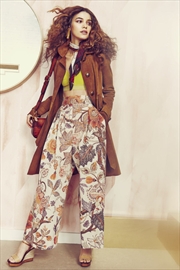What did the '70s look like? "Stylistically, it was a free-for-all," designer Betsey Johnson said of the tangy stew defining the era, a jumble of Harlowesque evening frocks, belled sleeves, flared pants, belted suede and wildly patterned caftans. Fashion in that showily dissolute decade was silky and caressing, silhouettes fluid and bras a relic of a straitjacketed past. So goes the lore.
"It was like you were walking around naked, but you had clothes on," said Phyllis Magidson, the curator of costumes and textiles at the Museum of the City of New York.
At the peak of that period, exalted in the popular mind as all that was kicky, inventive and louche, Magidson was in charge of wardrobe for soaps like "As the World Turns."

Before long, though, the languid sensuality that was part of an aesthetic flowering extending roughly from 1967 to 1973 had pretty well run its course.
And yet.
"Certain elements of the period — the garish prints and weird colour combinations — keep repeating," said Rebecca Arnold, a fashion historian at the Courtauld Institute of Art in London. So-called '70s style, Arnold added, is actually an aesthetic mash-up, one encompassing "sophisticated pantsuits, bohemianisms and a childlike play on the '60s baby-doll look."
That's to say nothing of the slippery fabrics, folksy embroideries, jumpsuits and swingy little dresses that might have been at home amid the glitter and grit of Studio 54.
Those long-ago emblems of worldliness — and waywardness — have now returned in force, with designers scrambling to loosely resurrect an era that keeps spinning like a continuous reel in their heads. Aptly enough, Tom Ford, who in the 1990s rescued the ailing house of Gucci with a '70s rock-infused collection, was prompt in his spring 2015 show to channel Bianca Jagger and other idols of the day, issuing a bell-bottom evening suit that conjured the dandyish regalia of Jagger's tabloid days.
Chanel paid homage to the Charlie girl, "kinda young, kinda now," with a bell-sleeve blouse and cropped wide-legged trousers, and Marc Jacobs offered a wide-sleeve camp shirt and loose pants covered somewhat subversively in a naïve-looking Liberty print. Rebecca Taylor offered a sweeping diaphanous maxi, Givenchy a studded leather vest, Gucci a supple suede trench that Lauren Hutton might have worn at the peak of her modeling career.
Who can help but plunder fashion's past when its imagery is everywhere? The epoch was captured on film in "American Hustle" and, more recently, in "Inherent Vice," the hemp-saturated reimagining of the Thomas Pynchon novel. It's vividly present in rock memoirs like "Just Kids," Patti Smith's recollections of coming of age in downtown Manhattan, and in trips through the decade by Kim Gordon of Sonic Youth and by Joni Mitchell, muse to the designer Hedi Slimane, who highlighted the singer in his Saint Laurent spring marketing campaign.
A wealth of pop ephemera is but a click away on Pinterest boards that worship at the altar of Ali MacGraw, looking womanly-provocative in the plunging silk dress or suede trench coat she wore in "The Getaway"; or Marisa Berenson vamping for Vogue in high hippie caftans, turbans and multiple rings; or Lisa Taylor, legs splayed suggestively as she poses for Helmut Newton in a Calvin Klein dress.
Clearly the period retains an emotional pull. In retrospect, the decade that spawned the DVF wrap dress, maxi-coats worn over hot pants, and Ladies of the Canyon in battered jeans seems a garden of earthly delights.
"We didn't have the consequences that we do for our actions today," said the costume designer Mark Bridges, whose film credits include "Boogie Nights" and "Inherent Vice." "People smoked without pause; you made out with who you wanted to; and on all fronts we were in an experimentation mode. Why not? The stakes weren't as high."
No comments:
Post a Comment